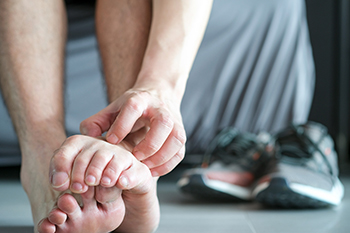 Pregnant women often deal with various foot-related issues because of the added weight when carrying a baby. One of the most common foot-related issues during pregnancy is swollen feet. This occurs when there is an excess of fluid that builds up and travels down to the feet. Because of this, raising and elevating the feet as much as possible, as well as wearing wide comfortable shoes, can help reduce the swelling. Arch pain is another common issue in pregnancy and can be eased by stretching the feet in the morning as well as after exercise. Ingrown toenails may also develop during during pregnancy, and they are another reason why wearing wide shoes is important. Pregnant women who get ingrown toenails or are struggling with other foot-related issues and pain may wish to consult with a podiatrist for suggested treatment options.
Pregnant women often deal with various foot-related issues because of the added weight when carrying a baby. One of the most common foot-related issues during pregnancy is swollen feet. This occurs when there is an excess of fluid that builds up and travels down to the feet. Because of this, raising and elevating the feet as much as possible, as well as wearing wide comfortable shoes, can help reduce the swelling. Arch pain is another common issue in pregnancy and can be eased by stretching the feet in the morning as well as after exercise. Ingrown toenails may also develop during during pregnancy, and they are another reason why wearing wide shoes is important. Pregnant women who get ingrown toenails or are struggling with other foot-related issues and pain may wish to consult with a podiatrist for suggested treatment options.
Pregnant women with swollen feet can be treated with a variety of different methods that are readily available. For more information about other cures for swollen feet during pregnancy, consult with one of our podiatrists from Biebel & DeCotiis Podiatry Associates. Our doctors will attend to all of your foot and ankle needs.
What Foot Problems Can Arise During Pregnancy?
One problem that can occur is overpronation, which occurs when the arch of the foot flattens and tends to roll inward. This can cause pain and discomfort in your heels while you’re walking or even just standing up, trying to support your baby.
Another problem is edema, or swelling in the extremities. This often affects the feet during pregnancy but tends to occur in the later stages.
How Can I Keep My Feet Healthy During Pregnancy?
- Wearing orthotics can provide extra support for the feet and help distribute weight evenly
- Minimize the amount of time spent walking barefoot
- Wear shoes with good arch support
- Wear shoes that allow for good circulation to the feet
- Elevate feet if you experience swelling
- Massage your feet
- Get regular, light exercise, such as walking, to promote blood circulation to the feet
If you have any questions please feel free to contact one of our offices located in Holmdel and Middletown, NJ . We offer the newest diagnostic and treatment technologies for all your foot and ankle needs.







 Bunions
Bunions
